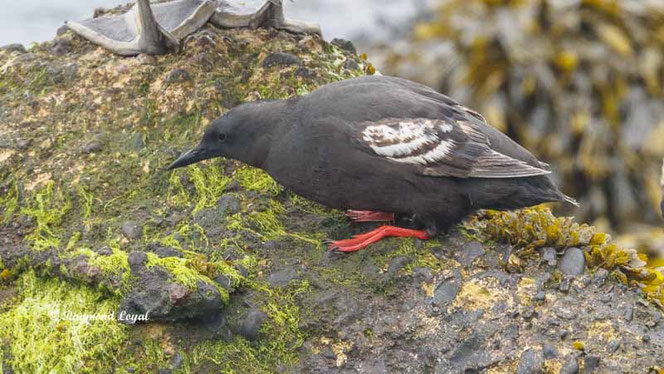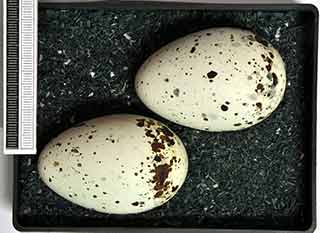Black Guillemot (Cepphus grylle)
The Black Guillemot is one the so-called Atlantic Auks and is distributed in subarctic and arctic zones. It breeds on Pacific and Atlantic shores of North America (including Bering Strait) and also on Greenland, Iceland and all larger arctic Eurasian archipelagos, including east Siberian islands.
The Black Guilemot also distributes in northwest Europe on Irish shores, in Scotland including Western Hebrides, Orkneys and Shetland, Norway, southern Sweden and Fennoscandia and also in the southern and western Baltics.
In the Wadden Sea we can watch Black Guillemots nearly all year round as migrants, over-summerer and during winter.
The world population is estimated at <350,000 breeding pairs, with European breeding population estimated at 130,000-300,000 breeding pairs.

Description - Characteristics: Black Guillemot
Breeding – Clutch – Measurements – Habitat – Diet - Threats
Taxonomy:
Order: Charadriiformes
Family: Alcidae
Genus: Cepphus
Species: Black Guillemot
Scientific Name: Cepphus grylle
Names and Synonyms of the Black Guillemot
Name in German: Gryllteiste
Name in Czech: Alkoun obecný
Name in Slovak: Svišťúň zrkadlový
Name in Hungarian: Fekete lumma
Name in Croat: Crna njorka
Name in French: Guillemot à miroir
Name in Spanish: Arao Aliblanco
Name in Portuguese: Arau-d'asa-branca
Name in Dutch: Zwarte Zeekoet
Name in Italian: Uria nera
Name in Iceland: Teista
Name in Faroer: Teisti
Name in Greenland: Serfaq
Name in North Sami: Cielkkis
Name in Finnish: Riskilä
Name in Danish: Tejst
Name in Swedish: Tobisgrissla
Name in Polish: Nurnik
Name in Russian: Чистик
Distribution – Movements – Habitat - Behaviour
Distribution: Breeding on the shores of the North Pacific and North Atlantic; North Atlantic shores: arctic northern America southwards to Newfoundland, Greenland, the arctic Eurasian archipelagos and eastwards to New Siberian Islands; northwest Europe southwards to the British Isles and southern Sweden.
Movements: Sedentary on the British Isles, otherwise migratory. Juveniles are migratory. Winter areas in the Baltics are reached between December to January, returning to breeding grounds between April and May.
Wintering: European Black Guillemots winter in the western and southern Baltics. Subspecies atlantis usually migrates no further than 300/400 km from breeding grounds
Habitat: Usually lives close to shorelines. Preferres rocky, pebble or sandy islands. Also between rocks at the base of steep cliffs. On bird cliffs usually on the lower floors.
Behaviour: Mostly diurnal. In flight much more agile than Common Guillemot. Flight over water surface but also at higher altitudes. Can dive to maximum depth of 18-20 m, average depth between 3.5-5 m. Diving time between 30-50 seconds.

Field Characteristics: Clearly smaller than Common Guillemot, larger than Puffin. Most outstanding feature are the red legs. Pointed black bill. Plump pot-bellied body. Adult shows large oval upperwing patches. Underwing white.
Bill: dark.
Tarsus: red.
Iris: dark.
Measurements
Size: 30-32 cm
Weight:
♂: 450-550 g
♀: 340-500 g
Wingspan: 52-58 cm
Wing: 19.9-18.2 cm

Voice: Mostly silent, except for breeding season, utters sounds like sipp-sipp-sipp” or similar.
Breeding
Maturity: at around 2 years of age, at the earliest. First breeding usually later.
Mating Season: after arrival at breeding area. Monogamous breeding pair, very loyal to nest site and former partner.
Clutches per breeding season1 clutch
Breeding: depending on geographical region, in Europe mainly from early May to late June.
Nest: Scratched mould, lined with any sort of material, nest sites in caves, half-caves, crevices, below stones, even below bar; also former nest tunnels of the sand martin.


Clutch: (1-) 2 (rarely -3) eggs
Eggs: creme-coloured broad oval egg with speckles and stains.
Egg Measurements:
Length: 53.0-68.0 mm
Width: 32.2-43.9 mm
Ø: 58.1x39.5 mm
Egg weight: 39.0-57.0 g
shell weight: c 3-5 g; Ø = 4.24 g (n=102 g)
Recurrent Clutch: possibly when clutch is lost during the early days. New clutch and laying of first egg within 12-23 days after loss.
Laying Interval: 2-4 (Ø 2.9±0.4) days, maximum recorded 6 days.
Begin of incubating: Mainly c. 24 hours after laying second egg.
Incubation: c. 25-36 days, both parents share the task of incubating, ♂ at night, ♀ during daytime. From laying the second egg to the second chicken fully hatched = 27-33 days.
Hatching: 3-4 days from first crack in the shell to the chicken finally out of shell. 24 hours between 1st and 2nd chicken, extreme = 4 days.
Fledging: 35-40 days, both parents feed. Siblings leave the nest within 3 days of each other.
Dependency: After fledging the juveniles are fully independent.

Miscellaneous
Food: fish, crustaceans, mullusks, bristle worms.
Longevity: The oldest known ringed birds of the Black Guillemot reached ages of >22 years, also >16-17 years.
Mortality: survival rate of Black Guillemots between fledging and maturity c. 33-53%.
Threats: Similar to all other auks: Oil pollution, especially after accidents on the seas. People collecting eggs on Faroe, in Norway and Great Britain. Losses by drowning in fishing nets. Overfishing especially on sprats, sandeels and herrings. High levels of heavy metals and pesticides. Disturbances at colonies. Predators: minks and rats.

References
Bauer, Hans-Günther, Bezzel, Einhard et. al. (HG), Kompendium der Vögel Mitteleuropas, Volume 1+2, Sonderausgabe 2012, Aula Verlag, Wiebelsheim
Bauer, Hans-Günther, Bezzel, Einhard et. al. (HG), Kompendium der Vögel Mitteleuropas, Volume 3, Literatur und Anhang, Aula Verlag Wiebelsheim, 2. vollständig überarbeitete Auflage 1993
Bezzel, Einhard, Kompendium der Vögel Mitteleuropas, Non-Passeriformes, Volume 1, AULA-Verlag Wiesbaden, 1985
Bruun/Singer/König/Der Kosmos Vogelführer, Franck'sche Verlagshandlung Stuttgart, 5. Auflage 1982
Glutz von Blotzheim, Urs et. al (HG), Handbuch der Vögel Mitteleuropas, Vol 8/II, Charadriiformes (Part 3), Akademische Verlagsgesellschaft Wiesbaden, 1982
Svenson, Lars et. al, Collins Bird Guide, Harper Collins London, 2009, revised and reprinded 2021
Image Credits
Egg of Common Guillemot - Source: by Klaus Rassinger und Gerhard Cammerer, Museum Wiesbaden - own works, CC BY-SA 3.0, https://commons.wikimedia.org/w/index.php?curid=35852793
